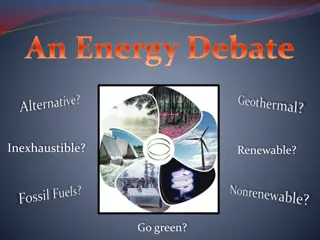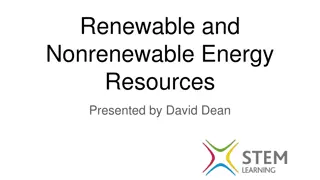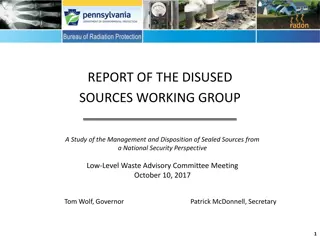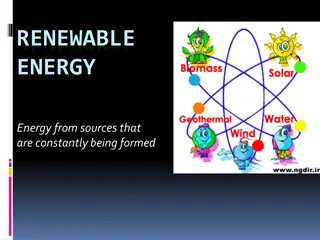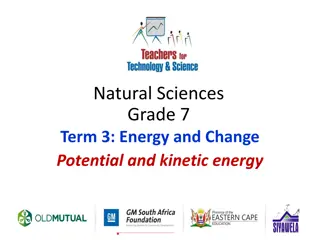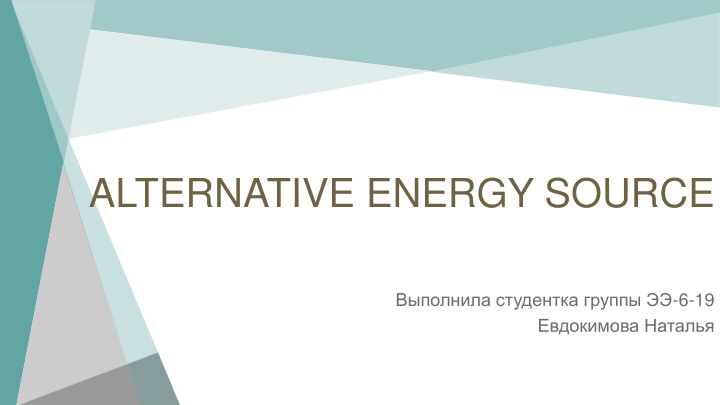
Alternative Energy Sources
Energy comes in renewable and non-renewable forms. Renewable sources like sunlight, wind, and water offer sustainable solutions. Solar and wind power are growing alternatives, while hydropower and tidal energy harness water for electricity generation. Transitioning to cleaner energy is essential for combating climate change and ensuring a sustainable future.
Download Presentation

Please find below an Image/Link to download the presentation.
The content on the website is provided AS IS for your information and personal use only. It may not be sold, licensed, or shared on other websites without obtaining consent from the author. If you encounter any issues during the download, it is possible that the publisher has removed the file from their server.
You are allowed to download the files provided on this website for personal or commercial use, subject to the condition that they are used lawfully. All files are the property of their respective owners.
The content on the website is provided AS IS for your information and personal use only. It may not be sold, licensed, or shared on other websites without obtaining consent from the author.
E N D
Presentation Transcript
Energy is renewable (alternative) and non-renewable (traditional). Alternative sources of energy are ordinary natural phenomena, inexhausti ble resources that are produced naturally. Such energy is also called rege nerative or "green." Non-renewable sources are oil, natural gas and coal. They are looking fo r a replacement because they can end. Their use is also associated with ca rbon dioxide emissions, the greenhouse effect and global warming.
Renewable energy resources Sunlight Water currents Wind The tides Biofuel (fuel from plant or animal raw materials) Geothermal heat (bowels of the Earth)
Solar power Most often, it is converted into electricity by solar panels. The whole planet has e nough energy for the whole year that the sun sends to Earth in a day. However, of the total volume, annual electricity generation at solar power plants does not exce ed 2%. The main disadvantages are the dependence on weather and time of day. For nort hern countries, extracting solar energy is unprofitable. The constructions are expe nsive, they need to be looked after and disposed of the photocells themselves, which contain toxic substances, in time. Huge areas are needed for high output. S olar electricity is common where it is cheaper than usual.
Wind power Wind energy reserves are 100 times greater than the energy reserves of al l rivers on the planet. Wind farms help convert wind into electrical, therm al and mechanical energy. The disadvantage is that it cannot be controlled (wind power is unstable). Even wind turbines can cause radio interference and affect the climate, b ecause they take part of the kinetic energy of the wind - however, scientis ts do not yet know whether this is good or bad.
Hydropower To convert the movement of water into electricity, hydroelectric power plan ts (HPS) with dams and reservoirs are needed. They are placed on rivers wit h a strong stream that do not dry out. Dams are built in order to achieve a ce rtain water pressure - it makes the blades of a hydraulic turbine move, and it drives electric generators. It is more expensive and more difficult to build hydroelectric power plants r elative to conventional power plants, but the price of electricity (at Russian hydroelectric power plants) is two times lower. Turbines can operate in diffe rent power modes and control the generation of electricity.
Tidal energy This energy is taken from the natural rise and fall of the water level. Power plants are installed only along the coast, and the water drop should be at lea st 5 meters. Tidal stations, dams and turbines are built to generate electricity . The ebbs and flows are well understood, therefore this source is more predi ctable relative to others. But technology adoption was slow and their share i n global production is small. In addition, tidal cycles do not always correspo nd to the rate of electricity consumption.





